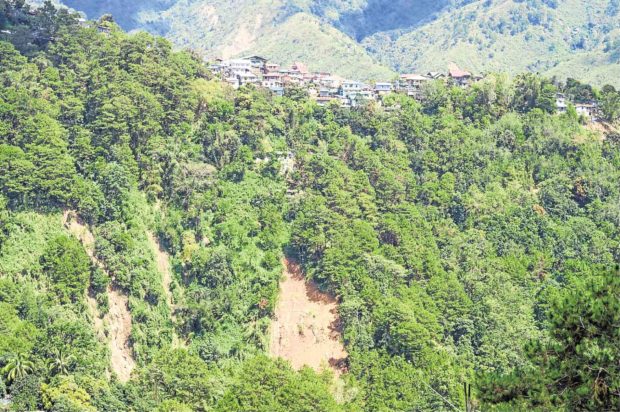ITOGON, Benguet — The local government is scrambling to find resettlement sites for communities as well as schools, when geologists confirmed that most of this mining town had been weakened after last month’s series of landslides.
Landslides on Sept. 15, which were triggered by Typhoon “Ompong,” (international name: Mangkhut) killed 89 residents, prompting the Mines and Geosciences Bureau (MGB) to study the town’s foundations and detected fault lines, horizontal cracks, ground displacements as well as natural and man-made voids underneath the earth, Mayor Victorio Palangdan said on Thursday.
Itogon’s latest geohazard map showed most areas were critical danger zones while other areas were highly susceptible to ground movement. Guided by the map, Palangdan declared 10 communities at the villages of Ampucao, Gumatdang, Loacan and Ucab as no-build zones.
Abandoned homes
As of Oct. 19, 720 families had abandoned their homes and were living with relatives or in boarding houses using subsidies from the Roman Catholic Diocese of Baguio.
Fourteen families were staying in evacuation tents put up by the Department of Social Welfare and Development at the community gym in the village of Tuding here.
The National Housing Authority released P20 million for the acquisition of lots for housing and for building materials. But the town government has difficulty looking for suitable areas, Palangdan said.
A 15-hectare titled lot at nearby Itogon town was offered to Itogon but Palangdan said the local government wanted to give priority to lands within Itogon as requested by the families.
Request
“[Displaced families] asked that the relocation sites should be near as much as possible to the areas where they came from because of their livelihood,” he said.
Residents used to make a living from small-scale mining, which was banned by Environment Secretary Roy Cimatu on Sept. 17.
On Wednesday, Cimatu said an 80-hectare “Minahang Bayan” (people’s mine), which would be established at the village of Loacan, could accommodate only 4,000 out of 12,000 miners covered by the ban.
Danger signs
Families were asked to identify alternative trades, for which they would be trained as part of a recovery program called “Save Itogon,” Palangdan said.
LOOKING FOR A PLACEDisplaced families take their meals outside tents set up in an Itogon gymnasium. —KARLSTON LAPNITEN
Relocating six elementary schools and two high schools in the danger zones has also become a priority for Itogon, he said.
The MGB said geologists had noted tension cracks and unaligned windows and doors at Ampucao National High School, Ampucao Elementary School and Manganese Elementary School in Barangay Ampucao; Goldfield Elementary School in Barangay Poblacion; Loacan National High School, Loacan Elementary School and Luneta Elementary School in Barangay Loacan; and Ucab Elementary School in Barangay Ucab.
Heavy rains, after a period of warm weather, could trigger landslides, said Liza Manzano, MGB supervising geologist.
“There is no last warning. Danger is imminent, they have to move out immediately,” she said.
On Thursday, classes were allowed to resume in these schools. Palangdan said officials of schools in danger zones had agreed to suspend classes on days when rains were expected.
Adjustment
Ucab Elementary School, which has more than 900 students, started adjusting schedules to accommodate all students in two buildings when five other buildings were declared unsafe by the MGB.
Students of Goldfield Elementary School hold classes in makeshift classrooms on a private lot.
Relocating schools is easier said than done, according to Carolyn Verano, Benguet supervisor of the Department of Education (DepEd).
She said the schools’ new sites should be near the communities, which would be difficult because of Itogon’s geological condition.
Government schools were also built using a standard design and engineering blueprint, which may not be suitable for Itogon’s terrain, she said.
Transfers
“Long distances from home to school may make parents hesitant to send their children to school,” she added.
Vivian Tawali, a resident, transferred her children to Alejo Pacalso Elementary School at the village of Tuding after learning about the condition of Ucab Elementary School.
“We already have no livelihood and have been told our homes may be unstable. I don’t want to live with the constant fear of losing my children in their classrooms,” Tawali said.
The UN Children’s Fund has donated four tents, which can be used as temporary classrooms. DepEd is also studying whether teachers can allow pupils to take home school work until replacement buildings were built, said Georaloy Palao-ay, DepEd Cordillera spokesperson.
